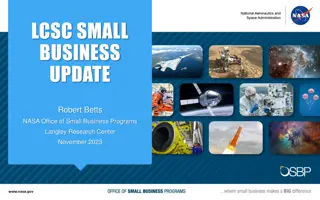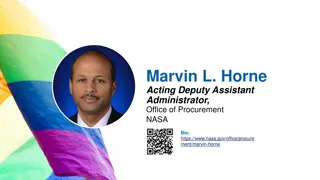Key Decisions and Priorities for a NASA Mission Meeting
This document outlines the decisions to be made during a NASA mission meeting regarding science priorities, instrument capabilities, technology policy, and mission requirements. Key topics include revising priorities, addressing weaknesses in science cases, defining mission requirements, and coordinating advocacy activities. The meeting aims to identify necessary themes, technology gaps, and boundary conditions for the mission. Various decisions are needed soon, such as determining requirements for exoplanet biosignatures and dealing with instrument capabilities exceeding allocations.
Download Presentation

Please find below an Image/Link to download the presentation.
The content on the website is provided AS IS for your information and personal use only. It may not be sold, licensed, or shared on other websites without obtaining consent from the author. Download presentation by click this link. If you encounter any issues during the download, it is possible that the publisher has removed the file from their server.
E N D
Presentation Transcript
Decisions, decisions Dave Leisawitz NASA GSFC 1 1 1
Decisions desired at this meeting Revise science priorities in light of new options tabled Fill any remaining gaps in science traceability for Concept 1 Identify any weaknesses in the OST science cases, and decide how to address the weaknesses through rigorous analysis Identify and trace instrument capabilities to the science themes and objectives Which themes and objectives are absolutely needed, or are they all needed? Define L1 mission requirements Decide how to dispose of open issues in Concept 1 Would STDT grant permission to change LV to something with fairing diameter > 5 m, if necessary? Decide on approach to defining boundary conditions for Concept 2 Will Concepts 1 and 2 have the same L1 requirements? If different, how would the change affect the science case for the mission, and the science instruments? 14 June 2017 D. Leisawitz - STDT f2f #5 2 2 2
Decisions desired at this meeting Decide on a technology policy for OST? What risk posture are we shooting for? (At one extreme, instruments could be allowed to incorporate any technology they choose, regardless of maturity level. Or we could limit the number of technologies anywhere in the mission allowed to have TRL < 4.) Identify complete set of technology gaps Decide how best to deal with excessive power required to read detectors Any immature technology embedded in instruments (e.g., cryogenic DM with enough correcting elements) How best to use limited resources to achieve advocacy goals? How to coordinate advocacy activities? Make writing assignments for Interim Report 14 June 2017 D. Leisawitz - STDT f2f #5 3 3 3
Decisions needed soon Is there a compelling and unique case for exoplanet biosignatures? How will stellar variability be dealt with? What are the L2 and L3 requirements? Resolve what to do about extraneous or difficult-to-achieve instrument measurement capabilities Not traceable to prioritized science Overlap in capability between instruments Instruments that greatly exceed mass, volume, power allocations Define boundary conditions for Concept 2 Instrument suite Primary mirror aperture size Where and when will we hold the next f2f meeting? 14 June 2017 D. Leisawitz - STDT f2f #5 4 4 4























